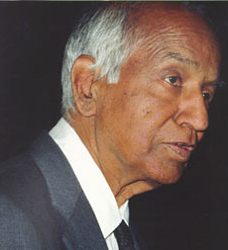Charles Babbage

The British computer pioneer Charles Babbage was very precocious as a child. When he was hardly eight, living in a school hostel, ghosts and devils fascinated him. He was keen to meet and befriend them and therefore conducted a systematic study of their habits, time and places of appearance ! Once he even visited an abandoned loft, drew a circle with his own blood and stood inside it, chanting mantras to invite them !
Homi J Bhabha

Homi J Bhabha, the founder of nuclear science in India, was a big lover of trees. Once on his way to BARC at Trombay, he saw some persons chopping a tree on the road. He stopped his car and enquired whether they had the requisite permission to cut down the tree. The persons told him they had bought the tree from the Municipal Corporation for the highest bid as it was to be removed because it fell on a road-widening lane. Bhabha earnestly requested them to stop chopping the tree as he would soon find a way to save it. When he reached BARC, he told the Head of the Landscape Architecture division of BARC, to look into the case, transplant the tree and save it. The Head promptly visited the site and reported that as the tree was badly mutilated, there was no point in buying it and transplanting it in Trombay. This angered Bhabha who immediately asked, "If you're a doctor, would you not save a patient who had 3rd degree burns which have disfigured his face ?" ! Finally, he ended up saving the tree !
Once , a highly confidential message for Bhabha from the dept. of Atomic energy, reached his personal assistant at Ooty. The latter wrote the message on a slip of paper, folded it and gave it to the young BV Sreekantan, who was then doing research in cosmic rays, and asked him to pass it onto Bhabha. In due course, Sreekantan joined Bhabha in his car on the way to the expt. site. Bhabha read the slip and passed it back to Sreekantan, saying, "This is strictly confidential. Please make sure you destroy this slip". Immediately, Sreekantan tore the slip into several bits and threw them out of the window of the car, In anger, Bhabha retorted, "It's fine you destroyed the slip but you've cluttered the treets of Ooty !".
Niels Bohr

Niels Bohr, the Danish physicist, who was renowned for modelling the internal structure of an atom, never believed in superstitions and pseudo scientific beliefs. But one day when another physicist HGB Casimir visited his country cottage, he was surprised to see a horse-shoe adorning the door. A horse-shoe is believed to bring luck to the owner.
"What's this ?", asked Casimir, pointing at the horse-shoe, when he was about to leave Bohr, "Do you believe in all this nonsense ?"
"No, no !", replied Bohr, shunning the subject, "Who said so ?"
"But, then, why have you....?" asked Casimir.
"Well, it still works, even if you don't believe in it !" replied Bohr, smiling.
Girolamo Cardano

The medieval Italian mathematician, Girolamo Cardano, was a cheat, gambler and rascal and was given to murderous rages. He was sent to prison several times for some crime or the other. However, he had a firm faith in astrology and went on to draw the horoscope of Jesus Christ for which he was sent to prison ! Using his mathematical acumen, he drew his own horoscope and even the date of his own death. But on the predicted day, he found himself quite hale and hearty. He could not stand this and, in a murderous rage, he killed himself !
Henry Cavendish

The British chemist-cum-physicist Henry Cavendish was an extremely shy person. He would prefer to avoid a person and keep to only his love - research. In fact, he would stutter if he has to speak to a person. He was scared of women and would try his best to avoid them. When it was difficult to avoid a house maid he would give instructions through written notes ! Only once, it is said, he saved a woman from a charging cow when he was on his solitary walk in the evening ! Due to his shyness, he could not even obtain a basic degree in science because it involved appearing for a test and an interview !
Subrahmanyam Chandrasekhar

Subrahmanyam Chandrasekhar, the eminent Indian astrophysicist was the nephew of the nobel laureate, CV Raman. However, CV Raman was never the role model for him. In fact, Raman always urged his nephew to leave astrophysics, which he called the 'backwaters of science' and shift to nuclear physics ! Chandrasekhar also politely rejected his uncle's invitation to join the Raman Research Institute as an assistant professor !
Once a sister-in-law of Chandrasekhar wanted to give him a gift and so asked him what he would like to have. He replied, "Give me a pencil because that's the only thing I use !".
John Dalton

John Dalton, the famous British scientist, had such a strong belief in Quaker religion which advocated the shunning of glory that he refused the Fellowship of the Royal Society when Humphry Davy nominated his name ! More than a decade later, he was quietly elected as a Fellow, without his knowledge !
Charles Darwin

During his teenage and youth, the eminent British naturalist, Charles Darwin, the propounder of the Theory of Evolution of Life, spent much of his time in hunting and collecting birds and animals. As he belonged to a family of physicians, his father considered him a waster and once even said to him, "You care for nothing but shooting, dogs and rat-catching, and you'll be a disgrace to yourself and all your family !"
Charles Darwin was terribly depressed till the end of his life by the way his now revolutionary book The Origin of Species was received by the scientific community. Most scientists laughed at his idea that man originated from apes. The press drew cartoons that portrayed him as an ape ! Even his own teacher called the idea 'utterly false and grievously mischievous !'
William Shockley

The American physicist, Nobel Laureate and inventor of the transistor, William Shockley became a controversial figure in the history of the USA when he openly declared that in the late sixties through his lectures and interviews that black Americans were a genetically inferior race and their population needs to be checked by giving them tax incentives ! He even went to urge scientists to study in detail 'dysgenics', defined as 'retrogressive evolution through the disproportionate reproduction of the genetically disabled.'
His open proclamations made him one of the most despised and vilified men in the USA. He was openly denounced as a fanatic, even as a Fascist ! His effigies were burnt in various universities and he was even debarred from teaching in some of the prestigious American universities ! Few scientists can equal him in this respect.
Curiously, Shockley's own invention, the transistor was used to amplify the shouts, "Off Pig Shockley !" directed at him at various meetings and protests. Once, when a demonstration was in progress against him, the loudspeaker went out of order. Coolly, Shockley approached the loudspeaker equipment and set it right, much to the amazement of the demonstrators !
Henry Augustus Rowland

During a trial, the American physicist Henry Augustus Rowland was asked who was the greatest American scientist, and he gave his own name ! Later, when he was asked how a modest person like him could give his own name, he replied he said so because he was bound by oath to speak truth !
Srinivasa Ramanujan

If you ever happen to see a photo of the Indian mathematician, Srinivasa Ramanujan, thank Subrahmanyam Chandrasekhar for that !
It so happened that Ramanujan's Cambridge benefactor Prof. GH Hardy was looking for his photograph because he intended to publish a series of lectures Ramanujan delivered at Harvard University in book form. Hardy was keen to include Ramanujan's photo in it but could not procure one ! On his visit to India Chandrasekhar made it a point to visit Mrs. Ramanujan in Chennai, who somehow managed to fish out an old passport size photo of the genius from an old trunk ! Today, it is the only photo of the genius available in the world ! Subsequently, based on that photo, a bust of Ramanujan was made in the USA.
CV Raman

The eminent Indian physicist and Nobel laureate, CV Raman was fond of talking to himself when he was doing research or doing an expt. Obviously, his students or assistants had to comply with a "yes, sir !" Sometimes it led to awkward situations.
Once Raman was discussing an experiment with his student A. Jayaraman. "I say, I am seeing a most remarkable effect in this crystal", said Raman, looking at the crystal. "It is absolutely fantastic and marvellous !"
"Yes, sir", agreed Jayaraman.
After a few minutes of seeing it, Raman continued, "I think I still see it. It may be there !"
"Yes, sir", Jayaraman nodded.
After a few minutes later, Raman continued, "I don't think there's any effect. It is all my imagination. I think I was foolish...."
"Yes Sir !.... Oh, no ! No, sir !"






